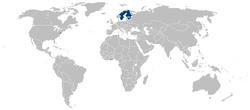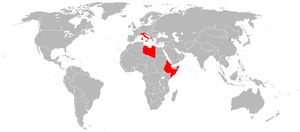Colonial empire

The Colonial empires began with a race of exploration between the then most advanced maritime powers, Portugal and Spain, in the 15th century. The initial impulse behind these dispersed maritime empires and those that followed was trade, driven by the new ideas and the capitalism that grew out of the European Renaissance. Agreements were also done to divide the world up between them in 1479, 1493, and 1494.
Portugal began establishing the first global trade network and empire under the leadership of Henry the Navigator. Portugal would eventually establish colonial domains from Brazil, in South America, to several colonies in Africa (namely Portuguese Guinea, Portuguese Cape Verde, Portuguese São Tomé and Príncipe, Portuguese Angola and Portuguese Mozambique), in Portuguese India (most importantly Bombay and Goa), in China (Portuguese Macau), and Oceania (most importantly Portuguese Timor), amongst many other smaller or short-lived possessions (see Evolution of the Portuguese Empire).
During its Siglo de Oro, the Spanish Empire had possession of the Netherlands, Luxembourg, Belgium, most of Italy, parts of Germany, parts of France, and many colonies in the Americas, Africa, and Asia. With the conquest of inland Mexico, Peru, and the Philippines in the 16th century, Spain established overseas dominions on a scale and world distribution that had never been approached by its predecessors (the Mongol Empire had been larger but was restricted to Eurasia). Possessions in Europe, Africa, the Atlantic Ocean, the Americas, the Pacific Ocean, and the Far East qualified the Spanish Empire as attaining a global presence in this sense.
From 1580 to 1640 the Portuguese Empire and the Spanish Empire were conjoined in a personal union of its Habsburg monarchs during the period of the Iberian Union, but beneath the highest level of government, their separate administrations were maintained.
Subsequent colonial empires included the French, English, Dutch and Japanese empires. By the mid 17th century, the Tsardom of Russia, continued later as the Russian Empire and the Soviet Union, became the largest contiguous state in the world, and the modern Russian Federation continues to be so to this day. Russia today has nine time zones, stretching across about half of the world's longitude.
The British Empire, consolidated during the period of British maritime hegemony in the 19th century, became the largest empire in history by virtue of the improved transportation technologies of the time. At its height, the British Empire covered a quarter of the Earth's land area and comprised a quarter of its population. During the New Imperialism Italy and Germany also built their Colonial empires in Africa.
After the Boxer Rebellion in 1901 the Imperial China ceded to the Eight-Nation Alliance (all the Great Powers of the time) some concessions. Since the end of the World Wars and by the end of the 20th century, most of the previous colonial empires have been decolonized.
List of colonial empires
- Portuguese Empire (1415 to 1999 - or present counting the Azores and Madeira islands possessions)
- Spanish Empire (1492 to 1975 - or present counting the Canary islands and North African possessions)
- French Empire (1534 to present)
- The French colonial empire
- The First French Empire of Napoleon I (1804–1814 or 1815)
- The Second French Empire of Napoleon III (1852–1870)
- The First and Second French Colonial Empire (1605–1962)
- French colonization of the Americas
- French Indochina
- List of Colony and possessions of France
- Tsardom of Russia, Russian empire, and Soviet Union (1580 to 1991)
- Russian Colonialism, Soviet Empire
- Russian conquest of Siberia
- Russian colonization of the Americas
- Soviet Central Asia
- South Caucasus
- Sagallo (Now Djibouti, 1889)
- Dutch Empire (1602 to present)
- English overseas possessions (1583 to 1707)
- Scottish colonization of the Americas (1621 to 1707)
- British Empire (1707 to present)
- Territories and mandates under Australian administration (1901 to 1975)[1]
- Territories and mandates under New Zealand administration (1907 to present)[2]
- Mandates under South African administration (1915 to 1990)[3]
- Evolution of the British Empire
- British colonization of the Americas
- East India Company and British Raj
- Danish colonial empire (1620 to present)
- Swedish colonial empire (1638 to 1663 and 1785 to 1878)
- Knights Hospitaller (Malta, a vassal of the Kingdom of Sicily; 1651 to 1665)
- German colonial initiatives (1683 to 1721, 1883 to 1919)
- Colonies of Brandenburg-Prussia (1683–1721)[4]
- German colonial empire (1883 to 1919)
- German colonization of the Americas
- Habsburg Monarchy colonies (1719–1750, 1778–1783, 1901–1917)[4]
- American Empire (1817-present)
- Japanese Empire (1868-1945)
- Belgian colonial empire (1885 to 1962)
- Congo Free State (1885 to 1908)
- Ruanda-Urundi (1922 to 1962)
- Italian Colonial Empire (1885 to 1943)
- List of possessions of Norway
-
.svg.png)
Japanese Empire
See also
- Colonial troops
- The empire on which the sun never sets
- History of Western civilization
- Great Divergence
- List of largest empires that existed in India
- Middle Eastern Empires
Notes and references
- ↑ The Australia dominion, itself a colony that gradually increased its independence in 1901, 1942 and 1986, was tasked with the government of multiple other British colonies and territories and the mandates of New Guinea and Nauru.
- ↑ The New Zealand dominion, itself a colony that gradually increased its independence in 1907, 1947 and 1986, was tasked with the government of multiple other British colonies and territories and the mandate of Samoa. It was also nominal co-trustee of the mandate of Nauru. The remaining non-self-governing New Zealand territory is Tokelau.
- ↑ The South-West Africa mandate was governed by the South Africa dominion, that itself a colony that gradually increased its independence in 1910, 1931 and 1961.
- ↑ 4.0 4.1 Part of the Holy Roman Empire realm before 1804.
- ↑ The dependencies of Norway are uninhabited, thus as end date is taken the latest date of full Norwegian sovereignty extension to such territory, instead of the date of decolonization or integration in the administrative structures of the mainland.
Bouvet Island claimed in 1927, under Norway sovereignty since 1930.
Peter I Island claimed in 1929, under Norway sovereignty since 1933.
Queen Maud Land claimed in 1938, under Norway sovereignty since 1957.
Peter I Island and Queen Maud Land fall under the scope of the Antarctic Treaty System since 1961.
External links
| ||||||||||||||||||||||||||||||||||||||||||||||||||||




.png)






